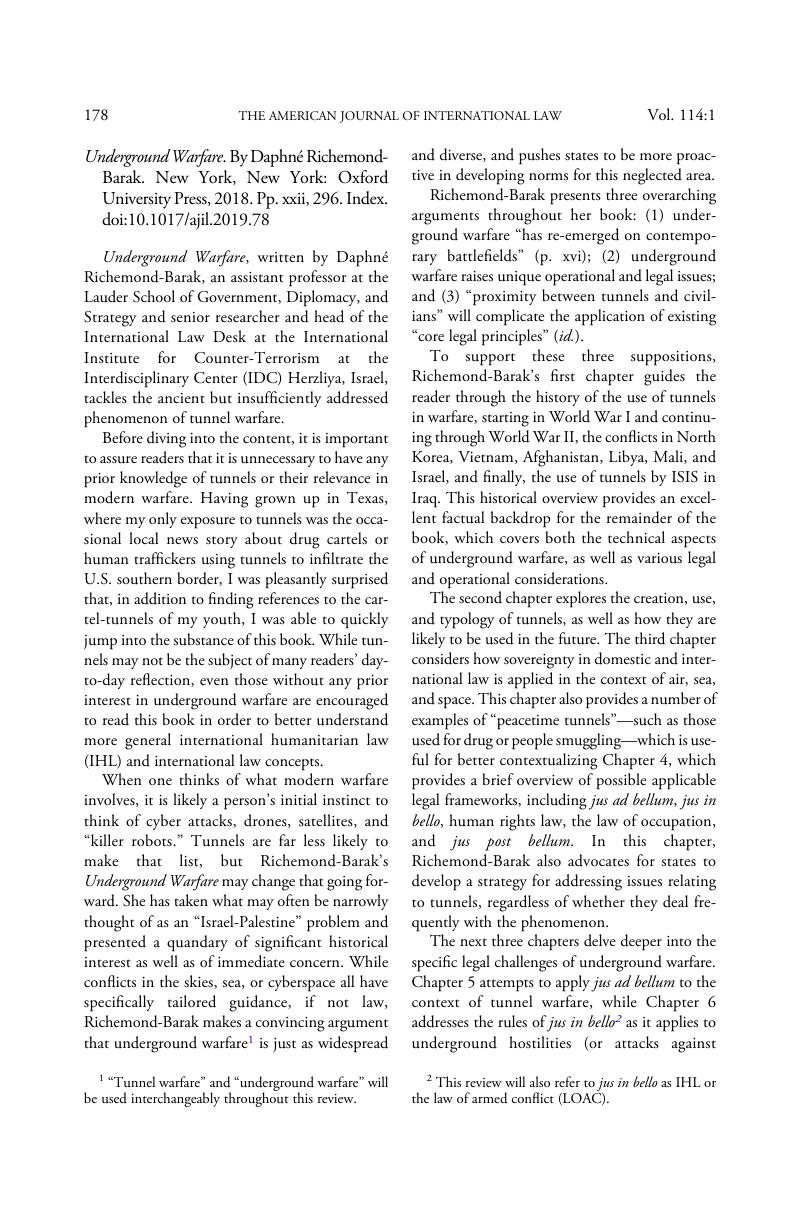No CrossRef data available.
Published online by Cambridge University Press: 17 January 2020

All views expressed in this review are solely those of the reviewer's and do not reflect the views of any institution with which the reviewer may be affiliated.
1 “Tunnel warfare” and “underground warfare” will be used interchangeably throughout this review.
2 This review will also refer to jus in bello as IHL or the law of armed conflict (LOAC).
3 Tallinn Manual on International Law Applicable to Cyber Warfare (Michael N. Schmitt ed., 2013) [hereinafter Tallinn 1.0].
4 Tallinn Manual 2.0 on the International Law Applicable to Cyber Operations (Michael N. Schmitt ed., 2d ed. 2017) [hereinafter Tallinn 2.0].
5 San Remo Manual on International Law Applicable to Armed Conflicts at Sea (June 12, 1994), available at https://ihl-databases.icrc.org/ihl/INTRO/560?OpenDocument.
6 HPCR Manual on International Law Applicable to Air and Missile Warfare (Program on Humanitarian Policy and Conflict Research at Harvard University, 2009), available at https://www.researchgate.net/profile/Claude_Bruderlein/publication/264036862_Manual_on_International_Law_Applicable_to_Air_and_Missile_Warfare/links/59a911d50f7e9b27900e2f0e/Manual-on-International-Law-Applicable-to-Air-and-Missile-Warfare.pdf.
7 See Tallinn 2.0., supra note 4, Rule 4 Commentary, at 19, para. 6.
8 See Gary Corn, Tallinn Manual 2.0 – Advancing the Conversation, Just Security (Feb. 15, 2017), at https://www.justsecurity.org/37812/tallinn-manual-2-0-advancing-conversation/#more37812 (“An opposing view holds that sovereignty is a baseline principle of the Westphalian international order undergirding binding norms such as the prohibition against the use of force in Article 2(4) of the UN Charter, or the customary international law rule of non-intervention, which States have assented to as an exercise of their sovereign equality.”).
9 See Tallinn 2.0., supra note 4, Rule 4 Commentary, at 19, para. 6.
10 See id., Rule 6.
11 See Tallinn 1.0,supra note 3, at 48–52.
12 See id. at 43.
13 Protocol Additional to the Geneva Conventions of 12 August 1949, and Relating to the Protection of Victims of International Armed Conflicts, June 8, 1977 [hereinafter Protocol I]. This definition is considered customary law, see Rule 8 of the ICRC's Customary Law Study on IHL. Richemond-Barak has explored the four criteria of nature, location, purpose, and use in relation to the targeting of tunnels and concludes that all four may be used to justify attacking tunnels (pp. 177–80).
14 See Brian Egan, Legal Adviser, Department of State, Remarks to the American Society of International Law: International Law, Legal Diplomacy, and the Counter-ISIL Campaign, Apr. 1, 2016 (describing “Insofar as objects are concerned, military objectives are those objects which by their nature, location, purpose or use make an effective contribution to military action and whose total or partial destruction, capture or neutralization, in the circumstances ruling at the time, offers a definite military advantage. The United States has interpreted this definition to include objects that make an effective contribution to the enemy's war-fighting or war-sustaining capabilities.”).
15 See U.S. Dep't of Defense, Law of War Manual, 210, para. 5.6.6.2 (2015) (“It is not necessary that the object provide immediate tactical or operational gains or that the object make an effective contribution to a specific military operation. Rather, the object's effective contribution to the war-fighting or war-sustaining capability of an opposing force is sufficient.”)
16 See Tallinn 1.0, supra note 3, Rule 38, para. 16.
17 See id., Rule 38, para. 18.
18 It should be noted that there is some other limited state practice on attacking ISIL oil refineries and Taliban opium production, which is described in detail in Goodman, Ryan, Targeting “War-Sustaining” Objects in Non-international Armed Conflict, 110 AJIL 663 (2016)CrossRefGoogle Scholar.
19 Int'l L. Ass'n Study Grp. on the Conduct of Hostilities in the 21st Century, The Conduct of Hostilities and International Humanitarian Law: Challenges of 21st Century Warfare, 93 Int'l L. Stud. 322, 341 (2017).
20 See Protocol I, supra note 13, Art. 57(2).
21 See Tallinn 1.0, supra note 3, Rule 57, para. 7.